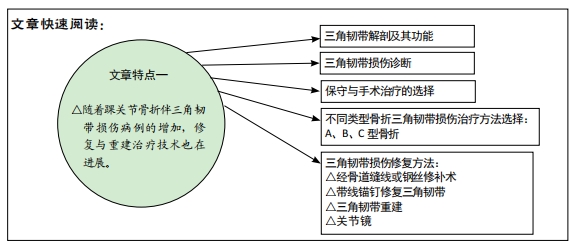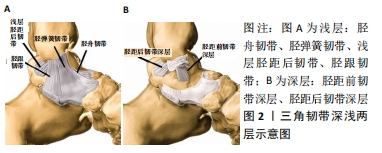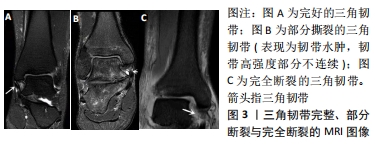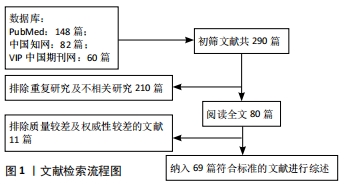[1] COURT-BROWN CM, CAESAR B. Epidemiology of adult fractures: A review. Injury. 2006;37(8):691-697.
[2] LOREN GJ, FERKEL RD. Arthroscopic assessment of occult intra-articular injury in acute ankle fractures. Arthroscopy. 2002;18(4):412-421.
[3] RIGBY R, SCOTT R. Role for primary repair of deltoid ligament complex in ankle fractures.Clin Podiatr Med Surg. 2018;35(2):183-197.
[4] LAMPRIDIS V, GOUGOULIAS N, SAKELLARIOU A. Stability in ankle fractures: Diagnosis and treatment. EFORT Open Rev. 2018;3(5):294-303.
[5] 张云, 杨云峰. 踝关节骨折合并急性三角韧带损伤的诊断和治疗进展 [J]. 中国修复重建外科杂志,2017,31(5):624-628.
[6] BASTIAS GF, FILIPPI J.Acute deltoid ligament repair in ankle fractures.Foot Ankle Clin. 2020;25(4):597-612.
[7] CAMPBELL K, MICHALSKI M, WILSON K, et al. The ligament anatomy of the deltoid complex of the ankle: A qualitative and quantitative anatomical study. J Bone Joint Surg Am. 2014;96(8):e62.
[8] LEE S, LIN J, HAMID K, et al. Deltoid ligament rupture in ankle fracture: Diagnosis and management. J Am Acad Orthop Surg. 2019;27(14):e648-e658.
[9] YAMMINE K.The morphology and prevalence of the deltoid complex ligament of the ankle. Foot Ankle Spec. 2017;10(1):55-62.
[10] PANCHANI P, CHAPPELL T, MOORE G, et al. Anatomic study of the deltoid ligament of the ankle. Foot Ankle Int. 2014;35(9):916-921.
[11] PANKOVICH AM, SHIVARAM MS.Anatomical basis of variability in injuries of the medial malleolus and the deltoid ligament. I. Anatomical studies. Acta Orthop Scand. 1979;50(2):217-223.
[12] CROMEENS B, KIRCHHOFF C, PATTERSON R, et al. An attachment-based description of the medial collateral and spring ligament complexes. Foot Ankle Int. 2015;36(6):710-721.
[13] FÖSEL A, SEIDEL A, ATTINGER M, et al. Ankle joint pressure in supination-external rotation injuries: A biomechanical study in an unrestrained cadaver model. Foot Ankle Spec. 2020;1938640020950183.
[14] TAKAO M, OZEKI S, OLIVA X, et al. Strain pattern of each ligamentous band of the superficial deltoid ligament: A cadaver study. BMC Musculoskelet Disord. 2020; 21(1):289.
[15] LAMOTHE J, BAXTER J, GILBERT S, et al. Effect of complete syndesmotic disruption and deltoid injuries and different reduction methods on ankle joint contact mechanics. Foot Ankle Int. 2017;38(6):694-700.
[16] LACK W, PHISITKUL P, FEMINO JE. Anatomic deltoid ligament repair with anchor-to-post suture reinforcement: Technique tip. Iowa Orthop J. 2012;32:227-230.
[17] MICHELSON JD, VARNER KE, CHECCONE M. Diagnosing deltoid injury in ankle fractures: The gravity stress view. Clin Orthop Relat Res. 2001;(387):178-182.
[18] HAYNES J, GOSSELIN M, CUSWORTH B, et al. The arterial anatomy of the deltoid ligament: A cadaveric study. Foot Ankle Int. 2017;38(7):785-790.
[19] DEANGELIS N, ESKANDER M, FRENCH B. Does medial tenderness predict deep deltoid ligament incompetence in supination-external rotation type ankle fractures? J Orthop Trauma. 2007;21(4):244-247.
[20] GILL J, RISKO T, RADUCAN V, et al. Comparison of manual and gravity stress radiographs for the evaluation of supination-external rotation fibular fractures.J Bone Joint Surg Am. 2007;89(5):994-999.
[21] PITAKVEERAKUL A, KUNGWAN S, ARUNAKUL P, et al. Radiographic parameters in gravity stress view of the ankle: Normative data. Foot Ankle Surg. 2019;25(6): 819-825.
[22] LEBA T, GUGALA Z, MORRIS R, et al. Gravity versus manual external rotation stress view in evaluating ankle stability: A prospective study. Foot Ankle Spec. 2015;8(3): 175-179.
[23] ROSA I, RODEIA J, FERNANDES PX, et al. Ultrasonographic assessment of deltoid ligament integrity in ankle fractures. Foot Ankle Int. 2020;41(2):147-153.
[24] JEONG M, CHOI Y, KIM Y, et al. Deltoid ligament in acute ankle injury: Mr imaging analysis. Skeletal radiology. 2014;43(5):655-663.
[25] WARNER S, GARNER M, FABRICANT P, et al. The diagnostic accuracy of radiographs and magnetic resonance imaging in predicting deltoid ligament ruptures in ankle fractures. HSS J. 2019;15(2):115-121.
[26] LEE T, JANG K, CHOI G, et al. The contribution of anterior deltoid ligament to ankle stability in isolated lateral malleolar fractures. Injury. 2016;47(7):1581-1585.
[27] BÄCKER H, VOSSELLER J, BONEL H, et al. Weightbearing radiography and mri findings in ankle fractures. Foot Ankle Spec. 2020;1938640020921571.
[28] NORTUNEN S, LEPOJÄRVI S, SAVOLA O, et al. Stability assessment of the ankle mortise in supination-external rotation-type ankle fractures: Lack of additional diagnostic value of mri. J Bone Joint Surg Am. 2014;96(22):1855-1862.
[29] HONG C, ROY S, NASHI N, et al. Functional outcome and limitation of sporting activities after bimalleolar and trimalleolar ankle fractures. Foot Ankle Int. 2013;34(6):805-810.
[30] LUO G, NI W, GUO S, et al. Effectiveness of repairing the deep layer of deltoid ligament by suture anchor repair method in treatment of mixed medial injury associated with ankle fractures. Zhongguo Xiu Fu Chong Jian Wai Ke Za Zhi. 2020;34(11):1387-1391.
[31] HSU AR, LAREAU CR, ANDERSON RB. Repair of acute superficial deltoid complex avulsion during ankle fracture fixation in national football league players. Foot Ankle Int. 2015;36(11):1272-1278.
[32] ZHAO HM, LU J, ZHANG F, et al. Surgical treatment of ankle fracture with or without deltoid ligament repair: A comparative study. BMC Musculoskelet Disord. 2017;18(1):543.
[33] SHEN JJ, GAO YB, HUANG JF, et al. Suture anchors for primary deltoid ligament repair associated with acute ankle fractures. Acta Orthop Belg. 2019;85(3):387-391.
[34] YU GR, ZHANG MZ, AIYER A, et al. Repair of the acute deltoid ligament complex rupture associated with ankle fractures: A multicenter clinical study. J Foot Ankle Surg. 2015;54(2):198-202.
[35] FITZPATRICK E, GOETZ JE, SITTAPAIROJ T, et al. Effect of posterior malleolus fracture on syndesmotic reduction: A cadaveric study. J Bone Joint Surg Am. 2018;100(3):243-248.
[36] SAGI HC, SHAH AR, SANDERS RW. The functional consequence of syndesmotic joint malreduction at a minimum 2-year follow-up.J Orthop Trauma. 2012;26(7):439-443.
[37] WU K, LIN J, HUANG J, et al. Evaluation of transsyndesmotic fixation and primary deltoid ligament repair in ankle fractures with suspected combined deltoid ligament injury. J Foot Ankle Surg. 2018;57(4):694-700.
[38] WOO S, BAE S, CHUNG H. Short-term results of a ruptured deltoid ligament repair during an acute ankle fracture fixation. Foot Ankle Int. 2018;39(1): 35-45.
[39] SCHEPERS T.To retain or remove the syndesmotic screw: A review of literature. Arch Orthop Trauma Surg. 2011;131(7):879-883.
[40] MANJOO A, SANDERS DW, TIESZER C, et al. Functional and radiographic results of patients with syndesmotic screw fixation: Implications for screw removal.J Orthop Trauma. 2010;24(1):2-6.
[41] MILLER A, PAUL O, BORAIAH S, et al.Functional outcomes after syndesmotic screw fixation and removal. J Orthop Trauma. 2010;24(1):12-16.
[42] WALLEY KC, HOFMANN KJ, VELASCO BT, et al. Removal of hardware after syndesmotic screw fixation: A systematic literature review. Foot Ankle Spec. 2017;10(3):252-257.
[43] DIAB HS. Suture anchor repair for ruptured deltoid ligament in pronation ankle fractures. 2017;28(5):459-464.
[44] WANG X, ZHANG C, YIN JW, et al. Treatment of medial malleolus or pure deltoid ligament injury in patients with supination-external rotation type iv ankle fractures. Orthop Surg. 2017;9(1):42-48.
[45] CHANG XB, WANG QY, XI HB, et al. [operation-effect analysis of 21 patients with ankle fracture and complete rupture of deltoid ligament].Zhongguo Gu Shang. 2020;33(7):655-658.
[46] TUCKER A, STREET J, KEALEY D, et al. Functional outcomes following syndesmotic fixation: A comparison of screws retained in situ versus routine removal - is it really necessary? Injury.2013;44(12):1880-1884.
[47] TARTAGLIONE J, ROSENBAUM A, ABOUSAYED M, et al. Classifications in brief: Lauge-hansen classification of ankle fractures. Clin Orthop Relat Res. 2015; 473(10):3323-3328.
[48] WEBER BG. Die verletzungen des oberen sprunggelenkes. Aktuelle Probl Chir. 1972;3:1-241.
[49] DANIS R. Les fractures malleolaires.//DANIS R, ed. Thorie et practique de l`osteosynthése. 1949:133-165.
[50] ZHANG Y, YANG Y. Progress of diagnosis and treatment of ankle fractures combined with acute deltoid ligament injury. Zhongguo Xiu Fu Chong Jian Wai Ke Za Zhi. 2017;31(5):624-628.
[51] LAUGE-HANSEN N. Fractures of the ankle. Ii. Combined experimental-surgical and experimental-roentgenologic investigations. Arch Surg. 1950; 60(5):957-985.
[52] BUTLER BA, HEMPEN EC, BARBOSA M, et al. Deltoid ligament repair reduces and stabilizes the talus in unstable ankle fractures.J Orthop. 2019;17:87-90.
[53] SUN X, LI T, SUN Z, et al. Does routinely repairing deltoid ligament injuries in type b ankle joint fractures influence long term outcomes? . 2018;49(12):2312-2317.
[54] LITTLE M, BERKES M, SCHOTTEL P, et al. Anatomic fixation of supination external rotation type iv equivalent ankle fractures. J Orthop Trauma. 2015;29(5):250-255.
[55] JONES C, NUNLEY J. Deltoid ligament repair versus syndesmotic fixation in bimalleolar equivalent ankle fractures. J Orthop Trauma. 2015;29(5): 245-249.
[56] DABASH S, ELABD A, POTTER E, et al. Adding deltoid ligament repair in ankle fracture treatment: Is it necessary? A systematic review.Foot Ankle Surg. 2019; 25(6):714-720.
[57] 汤俊君, 吴克俭, 张建, 等. 不同方式修复踝关节旋后外旋型ⅳ度骨折伴三角韧带完全断裂的初步疗效比较 [J]. 中华创伤骨科杂志, 2016, 18(6):470-475.
[58] 孙冶智,余磊,王伟,等.不同方式治疗踝关节骨折伴三角韧带完全断裂的临床效果观察[J].中国现代手术学杂志,2018,22(1):41-44.
[59] BOSZCZYK A, FUDALEJ M, KWAPISZ S, et al. Ankle fracture - correlation of lauge-hansen classification and patient reported fracture mechanism. Forensic Sci Int. 2018;282:94-100.
[60] 林文,于沈敏,蔡兵,等.锚钉修复三角韧带结合内固定治疗旋前外旋ⅳ度踝关节骨折 [J]. 创伤外科杂志,2017,19(1):61-63.
[61] 李凡,勘武生,黄珩,等.伴三角韧带完全断裂的踝关节骨折的治疗[J]. 中国矫形外科杂志,2009,17(24):1906-1908.
[62] VEGA J, GOLANÓ P, PELLEGRINO A, et al. All-inside arthroscopic lateral collateral ligament repair for ankle instability with a knotless suture anchor technique. Foot Ankle Int. 2013;34(12):1701-1709.
[63] 孙旭, 李庭, 孙志坚, 等. 三角韧带加强修补治疗合并三角韧带损伤及下胫腓分离的踝关节骨折 [J]. 中华医学杂志,2018,98(39):3192-3196.
[64] BAUMFELD D, BAUMFELD T, CANGUSSÚ J, et al. Does foot position and location of measurement influence ankle medial clear space?. Foot Ankle Spec. 2018;11(1):32-36.
[65] JUNG HG, PARK JT, EOM JS, et al. Reconstruction of superficial deltoid ligaments with allograft tendons in medial ankle instability: A technical report. Injury. 2016;47(3):780-783.
[66] KUSNEZOV NA, EISENSTEIN ED, DIAB N, et al. Medial malleolar fractures and associated deltoid ligament disruptions: Current management controversies. Orthopedics. 2017;40(2):e216-e222.
[67] SCHAIRER WW, NWACHUKWU BU, DARE DM, et al. Arthroscopically assisted open reduction-internal fixation of ankle fractures: Significance of the arthroscopic ankle drive-through sign.Arthrosc Tech. 2016;5(2):e407-412.
[68] CHIANG C, TZENG Y, JEFF LIN C, et al. Arthroscopic reduction and minimally invasive surgery in supination-external rotation ankle fractures: A comparative study with open reduction.Arthroscopy. 2019;35(9):2671-2683.
[69] CHAN KB, LUI TH. Role of ankle arthroscopy in management of acute ankle fracture.Arthroscopy. 2016;32(11):2373-2380.
|




